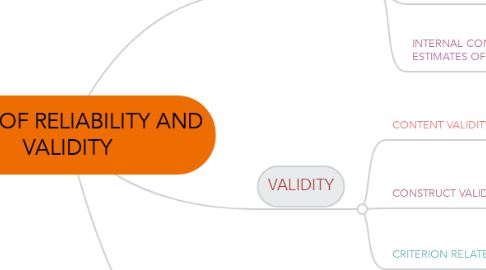
1. VALIDITY
1.1. CONTENT VALIDITY EVIDENCE
1.1.1. The extent to which the content of the test matches the instructional objectives.
1.1.1.1. A semester or quarter exam that only includes content covered during the last six weeks is not a valid measure of the course's overall objectives -- it has very low content validity.
1.2. CONSTRUCT VALIDITY EVIDENCE
1.2.1. The extent to which scores on the test are in agreement with (concurrent validity) or predict (predictive validity) an external criterion.
1.2.1.1. If the end-of-year math tests in 4th grade correlate highly with the statewide math tests, they would have high concurrent validity.
1.3. CRITERION RELATED EVIDENCE
1.3.1. The extent to which an assessment corresponds to other variables, as predicted by some rationale or theory
1.3.1.1. If you can correctly hypothesize that ESOL students will perform differently on a reading test than English-speaking students (because of theory), the assessment may have construct validity.
2. RELIABILITY
2.1. TEST, RETEST, STABILITY
2.1.1. Give the same assessment twice, separated by days, weeks, or months. Reliability is stated as the correlation between scores at Time 1 and Time 2.
2.2. ALTERNATIVE FORM ESTIMATES OF RELIABILITY
2.2.1. Create two forms of the same test (vary the items slightly). Reliability is stated as correlation between scores of Test 1 and Test 2. Create two forms of the same test (vary the items slightly). Reliability is stated as correlation between scores of Test 1 and Test 2.
2.3. INTERNAL CONSISTENCY ESTIMATES OF RELIABILITY
2.3.1. Compare one half of the test to the other half.
